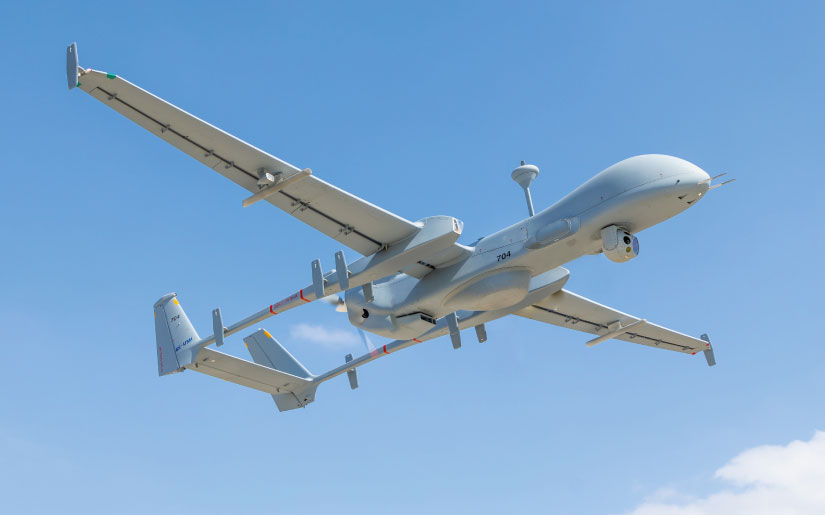In the wake of the tragic loss of four security personnel, the Indian Army has deployed Israeli-manufactured Heron drones to track down terrorists. The relentless counter-terrorism efforts persist in the Gadole region of Kokernag, located in South Kashmir’s Anantnag district.
According to reports, Heron drones, equipped with state-of-the-art surveillance technology, are actively engaged in operations above forested regions where terrorists are suspected to have taken refuge, leveraging the dense foliage and rugged terrain to their advantage.
The large-scale operation involving cutting-edge equipment commenced two days after India paid homage to Colonel Manpreet Singh alongside Major Aashish Dhonchal and J&K Deputy SP Himayun Bhat.
Following the death of senior officers, the Indian Army, in conjunction with the Jammu and Kashmir Police, initiated a concerted effort to track down the terrorists responsible for the attack.
The attack was claimed by The Falcon Squad, a faction within The Resistance Front (TRF), and they attributed it to retaliation for the recent killing of Mohammad Riyaz, a resident of Poonch, in Rawalkote, which is situated in Pakistan-controlled Kashmir.
Security officials have stated that they have successfully encircled two militants affiliated with Lashkar-e-Toiba, with one identified as Uzair Khan, a local commander.
Uzair Khan, who had only joined the militant ranks in 2022, ascended to the role of Lashkar commander in the region due to his in-depth knowledge of the local forested terrain and the surrounding areas.
Given the rugged and elevated terrain of the region, along with pockets of dense forest cover, the Indian Army has been prompted to utilize the Heron drones as part of their strategy to flush out the terrorists.
In addition to deploying Israeli Heron UAVs, the Indian Army has also incorporated small quadcopter drones to assist search efforts.
Furthermore, Special Forces commandos and additional troops have been called in, with the counter-insurgency Rashtriya Rifles units being placed on high alert. Again, all potential escape routes have been effectively sealed off.
IAF Heron Mark 2 Drones
The recently introduced Heron drones are believed to be participating in ongoing counter-terrorism operations. In August 2023, the Indian Air Force officially integrated its latest Heron Mark 2 drones into its arsenal.
These advanced drones, equipped with long-range missiles and diverse weaponry, possess both strike and surveillance capabilities, making them suitable for monitoring border areas.
The IAF squadron piloting the Heron Mark 2 drones bears the moniker ‘Warden of the North.’ Their primary mission involves conducting surveillance operations along the shared borders with China and Pakistan.
Four of these state-of-the-art Heron Mark-2 drones have been strategically positioned at a forward air base located within the northern sector.
The deal to acquire the 10 Heron MK II UAVs for the Indian Armed Forces from Israel Aerospace Industries was signed in mid-Jan 2021. In October 2022, EurAsian Times reported that New Delhi is negotiating with Israel to manufacture Heron Mk2 in India under license.

The Heron MK II is a Medium Altitude Long Endurance (MALE) Unmanned Aerial Vehicle (UAV) and represents an enhanced version of the Heron UAV.
According to the Israel Aerospace Industries or IAI, the Israeli Air Force employs it and operates within the arsenals of more than 20 organizations on a global scale.
The most notable aspect of the Heron MK II is its Standoff Capability, allowing it to collect intelligence from considerable distances, often spanning tens of kilometers, all without the need to breach borders.
IAF Wing Commander Pankaj Rana, the commanding officer of the drone squadron, previously told the news agency ANI that The Heron Mark 2 stands out as a competent drone. It boasts extended endurance and the remarkable ability to operate ‘beyond the line of sight.’ This means it can effectively surveil the entire country from the same place.
He mentioned that the extended endurance of the drone offers the advantage of conducting multiple missions and addressing numerous sectors within a single mission.
“The drone simply amalgamates into the Intelligence, surveillance, and reconnaissance matrix of the Indian Air Force,” Rana stated.
Emphasizing a vital strength of the drone, he highlighted its capability to provide continuous 24×7 surveillance of targets. Furthermore, modern avionics and improved engines have increased operational aircraft ceilings.
The Indian Air Force maintains a fleet of over 180 Israeli-manufactured UAVs, including 108 Searchers made by IAI and 68 Heron 1s, primarily used for surveillance and intelligence gathering.
The service also operates IAI-produced Harpy UAVs equipped with high-explosive warheads designed to self-destruct upon engaging targets.
- Contact the author at ashishmichel(at)gmail.com
- Follow EurAsian Times on Google News